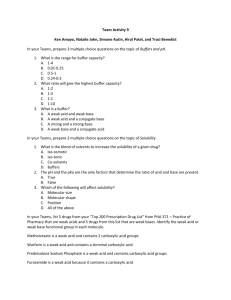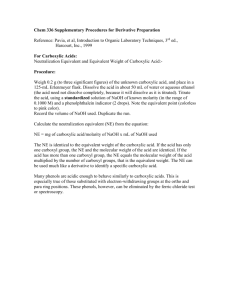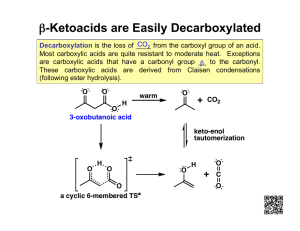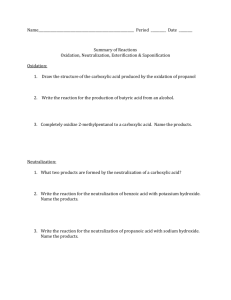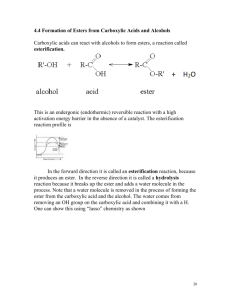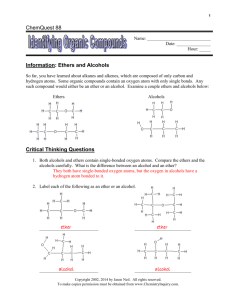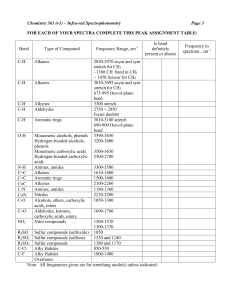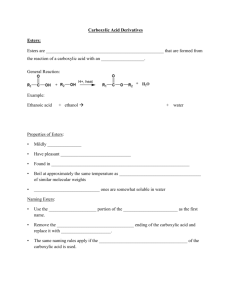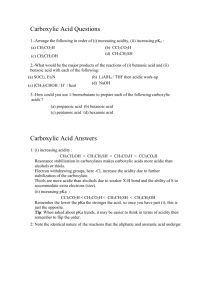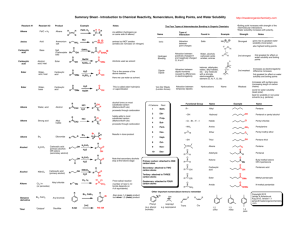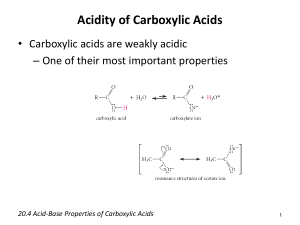mock exam TR - Chemistry 107 SI
advertisement
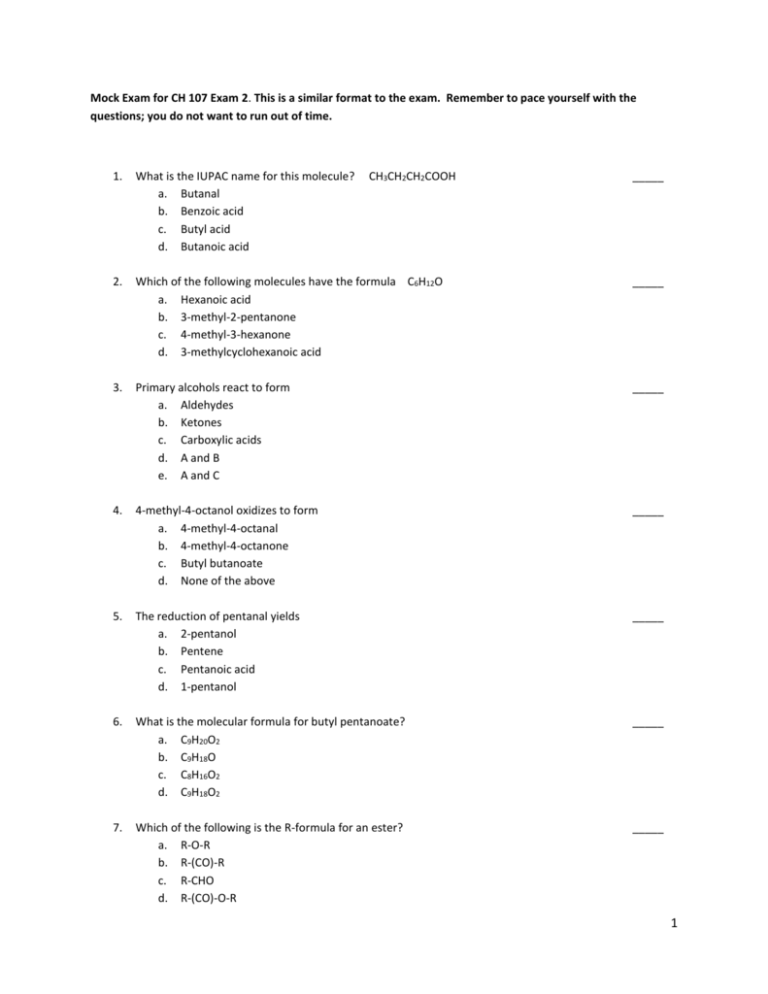
Mock Exam for CH 107 Exam 2. This is a similar format to the exam. Remember to pace yourself with the questions; you do not want to run out of time. 1. What is the IUPAC name for this molecule? a. Butanal b. Benzoic acid c. Butyl acid d. Butanoic acid CH3CH2CH2COOH _____ 2. Which of the following molecules have the formula C6H12O a. Hexanoic acid b. 3-methyl-2-pentanone c. 4-methyl-3-hexanone d. 3-methylcyclohexanoic acid _____ 3. Primary alcohols react to form a. Aldehydes b. Ketones c. Carboxylic acids d. A and B e. A and C _____ 4. 4-methyl-4-octanol oxidizes to form a. 4-methyl-4-octanal b. 4-methyl-4-octanone c. Butyl butanoate d. None of the above _____ 5. The reduction of pentanal yields a. 2-pentanol b. Pentene c. Pentanoic acid d. 1-pentanol _____ 6. What is the molecular formula for butyl pentanoate? a. C9H20O2 b. C9H18O c. C8H16O2 d. C9H18O2 _____ 7. Which of the following is the R-formula for an ester? a. R-O-R b. R-(CO)-R c. R-CHO d. R-(CO)-O-R _____ 1 8. What is the molecular formula for 3-hydroxyoctanal? a. C8H18O b. C8H16O c. C8H16O2 d. C8H18O2 _____ 9. ____________ and ____________ will are required to form butyl hexanoate. a. Hexanol Butane b. Hexanol Butanoic acid c. Butanol Hexanal d. Butanol Hexanoic acid _____ 10. The reduction of 2-methyl-3-heptanone will yield a. 2-methyl-2-heptanol b. 2-methylheptanal c. 2-methyl-3-heptanol d. Ethyl pentanoate _____ 11. Which of the following will have the highest water solubility? a. 2-methylpentanal b. 1-pentanol c. Pentane d. Methyl butyl ether _____ 12. Which of the following is NOT soluble? a. 2-hexanone b. Butanone c. Pentanal d. Butanal _____ 13. The reaction of an aldehyde or ketone with an alcohol will form a(n) a. Acetal b. Hemicacetal c. Carboxylic acid d. Ester _____ 14. What is the name of the reaction between a carboxylic acid and an alcohol? a. Esterification b. Dehydration c. Oxidation d. Reduction _____ 15. The reaction of a carboxylic acid with a(n) __________ forms an ester. a. Ether b. Alcohol _____ 2 c. d. Alkane Aldehyde 16. What is the name of this molecule? CH3CH2CH2COOCH2CH3 a. Pentyl ester b. Propyl ethanoate c. Propyl acetate d. Ethyl propanoate _____ 17. These tend to have pleasant odors and are used for flavor. a. Ethers b. Carboxylic acids c. Carbohydrates d. Esters _____ 18. The neutralization of acetic acid by KOH produces a. Potassium acetylaldehyde b. Potassium acetate + H2O c. Potassium permanganate d. Ethyl alcohol _____ 19. The reaction of a carboxylic acid with an alcohol with produce a(n) a. Ether b. Carboxylic acid salt c. Ester d. Hemiacetal _____ 20. The reaction in number 19 is known as a. Saponification b. Neutralization c. Esterification d. Reduction _____ 21. Which of the following will alcohols NOT react to form? a. Ketones b. Ethers c. Aldehydes d. Carboxylic acids e. Esters _____ 3 22. Identify how many chiral carbons are in the following molecule. a. b. c. d. _____ 4 3 2 8 23. Which of the following Greek letters refers to carbon number 3 in carboxylic acids? a. α b. β c. ϒ d. δ _____ 24. The product of the oxidation of 3-methylheptanol is: a. 3-methylheptanone b. 3-methyl-2-heptanal c. 3-methylheptanal d. 3-methylheptene _____ 25. Which of the following is the molecular formula for ethyl butanoate? a. C6H10O2 b. C7H12O c. C6H12O2 d. C6H12O _____ 26. Which of the following is the basis for aspirin and oil of wintergreen? a. Acetic acid b. Salicylic acid c. Hexanol d. Formic acid _____ 27. Under acidic conditions, esters hydrolyze to _________ and _________ a. Carboxylic acid and a base b. Carboxylic acid and water c. Carboxylic acid salt and base d. Carboxylic acid and alcohol _____ 28. Alcohols and ethers are considered to be ___________________. a. Chiral b. Structural isomers c. Stereoisomers d. Enantiomers _____ 4 29. 3-hexanol will oxidize to form ________________. a. 3-hexanal b. 3-hexanone c. 3-hexanoate d. No reaction _____ 30. Tertiary alcohols can react to form: a. Aldehydes b. Ketones c. Carboxylic acids d. A and c e. No reaction _____ Short Answer: Answer any 4 of the following 6 questions. If you do all 6, he will only grade the first 4 (even if you got number 5 right and number 3 wrong, you will get ¾ correct…so be careful!) 31. Write the complete esterification reaction for the formation of an ester of your choice that has 10 carbons. Name the reactants and products. 32. Name and draw the product for the following oxidation reactions. a. 2-pentanol b. 3-ethyl-1-heptanol H2O + H2O + 5 c. 3-ethyl-3-heptanol H2O + 33. Complete the following reaction. Give the name of the reaction as what the general terms for the reactant and products. CH2-O(CO)-CH3 CH-O(CO)-CH2CH2CH3 CH2-O(CO)-CH2CH2CH2CH2CH3 + 3NAOH 34. Discuss salicylic acid, including the molecules that it is the basis for. 35. Draw a cartoon for a polyester and label the components and linkages. How are polyesters formed? 36. Draw and name any 5 molecules with the formula C7H14O. (on the back is okay) 6
